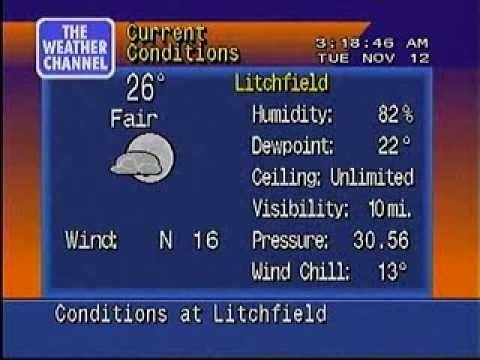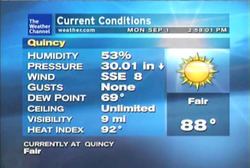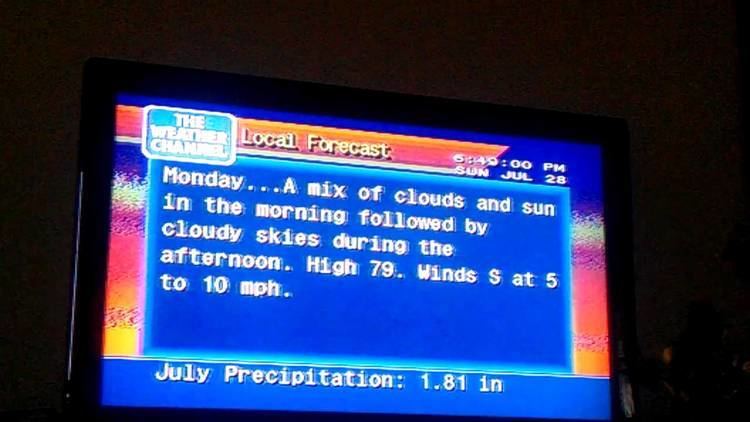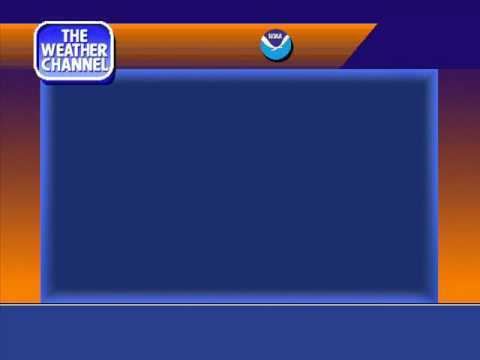 | ||
Weatherstar postcards
WeatherStar (sometimes rendered Weather Star or WeatherSTAR; "STAR" being an acronym for Satellite Transponder Addressable Receiver) refers to the technology used by American cable and satellite television network The Weather Channel (TWC) to generate its local forecast segments (currently known under the brand Local on the 8s) on cable and IPTV systems nationwide. The hardware takes the form of a computerized unit installed at a cable system's headend. It receives, generates, and inserts local forecast and other weather information, including weather advisories and warnings, into TWC's national programming.
Contents
- Weatherstar postcards
- All in your head weatherstar with lyrics new song
- Overview
- History
- Weather Star I
- Weather Star II
- Weather Star III
- WeatherStar 4000
- WeatherStar Jr
- WeatherStar XL
- IntelliStar
- IntelliStar 2
- IntelliStar 2 Jr
- Intellistar 2 xD
- WeatherStar products
- References

All in your head weatherstar with lyrics new song
Overview

The primary purpose of WeatherStar units is to disseminate weather information for local forecast segments on The Weather Channel. The forecast and observation data – which is compiled from the National Weather Service, the Storm Prediction Center and The Weather Channel itself (which began providing forecasts for TWC in 2002 that replaced the National Weather Service's zone forecasts used in the STAR's descriptive forecast product) – is received from the vertical blanking interval of the TWC video feed and from data transmitted via satellite; the localized data is then sent to the unit that inserts the data and accompanying programmed graphics over the TWC feed. The WeatherStar systems are typically programmed to cue the local forecast segments and Lower Display Line at given times. The units are programmed to feature customized segments known as "flavors," which are pre-determined variables in the products displayed during each local forecast segment; this allows certain types of products to be added or removed from the segment depending on the time of broadcast (with the extended forecast usually being exempted from removal), and also allows the reduction or extension of the segment lengths. Flavor lengths previously varied commonly between 30 seconds and two minutes, with some running as long as five minutes the late 1980s and the mid-1990s; in April 2013, the length of these flavors was changed to a uniform one-minute span.

Outside of the regularly scheduled full-screen graphical segments, weather data is also inserted over the channel's national feed via the Lower Display Line (LDL); the LDL was originally displayed as a text-only overlay over the bottom third of the video feed on older STAR units up to the Weather Star Jr. model, containing no graphical background and only showing current weather observations and monthly precipitation totals for the chosen reporting station (the text LDL was removed when The Weather Channel added an LDL specific to the national feed on March 11, 2010). A semi-translucent background was introduced to the LDL with the release of the Weather Star XL, which added local weather forecasts; the IntelliStar later added air quality indexes, travel forecasts for three cities in the region, traffic information and almanac data among the products it displayed. The LDL used on IntelliStar units was redesigned on November 12, 2013, and began to appear throughout all programming on the national feed (including commercial breaks and telecasts of its long-form programs), while being replaced by a segment rundown/progress bar on the full-screen forecast segments. A sidebar was also paired with the LDL on the right third of the screen, visible only to those watching the channel's high definition simulcast feed, which generates supplementary data (including average delay times for area airports; visibility, dew point and barometric pressure data, which was previously shown on the LDL; air quality forecasts; and almanac data); unlike the LDL, the sidebar is removed during commercial breaks and is only shown during the channel's forecast programming.

All STAR systems are able to display watches, warnings and advisories issued by the National Weather Service and the Storm Prediction Center for the immediate area where the WeatherStar system's headend is based, which generate a tone as an audible leader to the alert message. Older STAR units up to the WeatherStar 4000 displayed NWS bulletins in the form of a full-screen vertical scroll with differing colored backgrounds (brown for advisories and red for warnings), which was paired with the Lower Display Line. However, the 4000 introduced a horizontal ticker that was restricted to the bottom third of the TWC video feed; since November 12, 2013, IntelliStar models now display alerts over the national feed's headlines ticker placed above the LDL. Test alerts are also generated that are viewable only by cable company technicians performing silent remote administration tests.

The systems are also capable of generating multiple scrolling text advertisements that appear at the bottom of the screen during local forecast segments, which are programmed into the administrative menus by a locally based technician employed by the provider. STAR units are also capable of generating advertising tags for overlay on national advertisements seen on the national feed, displaying localized addresses for retailers, and on newer models, tagging products seen during breaks (such as pollen reports).
History

Since its introduction at TWC's launch in May 1982, several generations of the WeatherStar have been used. As of 2015, three STAR models (the IntelliStar, IntelliStar 2 and IntelliStar 2 Jr.) are currently being used by cable and IPTV providers for generation of local weather information on the channel.
Weather Star I
The original WeatherStar system, the Weather Star I, was released upon The Weather Channel's launch. Like subsequent WeatherStar units, it received local weather data from TWC and the National Weather Service, via data encoded in the vertical blanking interval of TWC's video feed, as well as receiving extra data from a subcarrier transmitted above TWC's video and audio signals on its transponder on satellite. The Weather Star I was manufactured and developed for TWC by Salt Lake City, Utah-based Compuvid. A couple of years before TWC was founded, Compuvid had already made a similar product which was installed at the headends of cable television systems owned by Landmark Communications, TWC's corporate parent at the time and the channel's founding owner. This system displayed weather conditions, forecasts and announcements via a set of weather sensors locally installed at the cable headend. The Weather Star I was an updated version of this unit, receiving data from both The Weather Channel and the National Weather Service.
The Weather Star I, like its two subsequent successors, lacked the ability to generate graphics and was only capable of displaying white text on various backgrounds: purple for the "Latest Observations" (which displayed current weather conditions for the nearest reporting station and others within 75 miles (121 km) of the headend location) and "Weather Information" (which displayed random data, usually weather-related trivia, past weather events in the area, or information on upcoming programming) pages, grey for the "36 Hour Forecast" page (a descriptive forecast using the National Weather Service's zone forecast products), brown for scrolling weather advisories, and red for scrolling weather warnings. Until the release of the Weather Star III, The Weather Channel only used a single one-minute local forecast sequence featuring each of the three above-mentioned forecast screens. As with all future WeatherStar models, the Weather Star I could key its text over TWC's national video feed, most often to display the current conditions at the bottom of the screen.
Even though the Weather Star I met the Federal Communications Commission's Part 15 regulations for emanated RF interference (RFI), it still radiated enough to interfere with VHF channel 2 on the broadcast band, resulting in problems at the cable television system's headend where the Weather Star I unit was installed. This problem was temporarily solved by having ferrite chokes attached to all cables and wires attached to the Weather Star. The Weather Star I was also notorious for frequent text jamming and text garbling issues.
Weather Star II
The Weather Star II was released in 1984; the unit had improved RF shielding to reduce interference issues and had an improved overall hardware design. Otherwise, the unit was similar in its features to the Weather Star I.
Weather Star III
The Weather Star III, released in 1986 as an upgrade to the Weather Star II, was another text-only unit that was essentially identical to the two prior WeatherStar models, though with additional internal improvements and forecast products (and consequently, more local forecast sequences). However, TWC decided to drop one of the products included in the unit, "Weather Information," soon after the introduction of the STAR III.
In 2001, the FCC granted The Weather Channel a waiver from complying with its forthcoming requirement for aural tones to accompany broadcast of "scrolled" or "crawled" emergency information, which otherwise went into effect in 2002, for the Weather Star Jr. and Weather Star III. The Weather Star III was capable of generating an aural tone only during the first display of a weather warning, not every time it was shown, as required by the regulations. The waiver, which expired on December 31, 2004, was granted with the understanding that TWC would "replace the Star IIIs in 2003/2004". TWC released an "Audio Weather Alert Enhancement" for the Weather Star Jr. and Weather Star III in June 2004, so that they would emit "a series of audible beeps" every time a tornado warning, flash flood warning or severe thunderstorm warning issued by the National Weather Service was transmitted for insertion over the TWC feed.
The Weather Star III was retired completely in December 2004. From 1989 to 1992, The Weather Network and its French language sister network MétéoMedia – the Canadian equivalents of TWC – used the Weather Star III units to display local forecasts, which were displayed over a sky blue background, a colour that TWC's units did not use.
WeatherStar 4000
The Weather Star 4000 was the first WeatherStar model capable of displaying graphics. First developed in 1988, it was introduced in early 1990. It was designed and manufactured by Canadian electronics company Applied Microelectronics Institute (now Amirix). The first Star 4000s were programmed to operate in a text-only mode (displayed over stylized graphical backgrounds), similar to the STAR III, but with two improvements: an improved font was introduced, as was a graphical radar product at the end of the local forecast segment, showing precipitation that was occurring in the viewer's local geographic area. The first version was just a static (current) image. A second version was added in the fall of 1992, and was a loop showing radar data logged during the previous 90 minutes. Within a brief period of time, the Weather Star 4000 began to produce graphically based local forecast segments, including maps for the regional observation and forecast products. Until 1995, the Star 4000 incorporated a narration track provided by Dan Chandler into the software, which introduced forecast products presented in each flavor; the tracks could be programmed to play either on certain products or all that were featured during that particular flavor. A customized version of the Weather Star 4000 was used by The Weather Network until 1997, when it switched to a technically different system to disseminate local weather information, known as PMX. Due to the cost of upgrading to more advanced units including the IntelliStar, the Weather Star 4000 remained in use in some smaller communities as late as 2014, although it was already being gradually phased out in some areas in favor of the more recent models at that time.
WeatherStar Jr.
The Weather Star Jr. was a budget model manufactured by Wegener Communications for cable headends in smaller communities. Released in 1994 following field testing on eight cable systems in various smaller markets, the system was based on Wegener's Series 2450 graphics display platform, and cost US$500 per unit. It featured the same products used by the Star III, but utilized the typeface used by the 4000. The Weather Channel was able to upgrade Weather Star Jr. units to meet the FCC's 2002 deadline to require broadcasts of "scrolled" or "crawled" emergency information to be accompanied by an aural tone for accessibility reasons. When the change in FCC regulations forced the retirement of the Star III, headends using that unit upgraded to the Weather Star Jr. or more advanced units.
WeatherStar XL
In the fall of 1998, the Weather Star XL, the fifth-generation system in the WeatherStar fleet, was introduced. The Star XL, an IRIX-based computer unit manufactured by SGI, had significantly more advanced technical capabilities than the 4000; it incorporated modernized graphics (with Akzidenz-Grotesk as the main typeface) and a new set of weather icons that would be used on the channel for eight years after its launch. Its on-screen appearance was originally based off those used on the channel's program introductions that were introduced shortly beforehand, but were eventually replaced by a graphics set that closely resembled the original graphical design of the WeatherStar's successor, the IntelliStar.
The Star XL was also the first WeatherStar platform to be adapted and modified by The Weather Channel for use on its sister service Weatherscan, a 24-hour local weather channel carried on select cable systems throughout the country (primarily on digital tiers) that launched in 1999; three years later, the Weatherscan XL units would be phased out for use on Weatherscan (and eventually, on TWC in most large and mid-sized markets) and replaced by the newer IntelliStar technology as part of the first trial of the system. The Star XL model has a high manufacturing cost (US$6,500) and weighs 55 pounds (25 kg). It was also the first STAR system to utilize Vocal Local, a software function that is technologically different from the narration track used in the WeatherStar 4000, which assembles pre-recorded audio tracks to provide narration of the current temperature and sky conditions, descriptive forecasts and introductions to certain forecast products.
The XL, along with the WeatherStar 4000 and WeatherStar Jr. systems, were retired when The Weather Channel discontinued transmission of its analog satellite feed on June 26, 2014.
IntelliStar
In February 2003, TWC released an advanced model, IntelliStar, initially being rolled out for use on Weatherscan; the "domestic" version intended for use on The Weather Channel was subsequently introduced in early to mid-2004 in the top media markets (including Dallas, Los Angeles, Philadelphia and Pittsburgh). Initially, its graphics were essentially the same as those seen on the WeatherStar XL (though it used Interstate, which was used by TWC for its on-air graphics package at the time, as the typeface instead of Akzidenz-Grotesk) until December 2006, when the IntelliStar received its own, even more realistic icon set – which were used on TWC's on-air and online forecast content as well.
The amount of weather products provided by the IntelliStar had dramatically increased with the revamp: with the addition of schoolday and daypart forecasts; ultraviolet indexes and other health information; and the introduction of more localized maps for forecasts and radar/satellite imagery. However, most of the products were dropped in April 2013, when the channel uniformally reduced its local forecast segments to one minute (instead of varying between one and two minutes, depending on the segment). Some of the data added was also incorporated into the Lower Display Line, which eventually added a tabbed display for each product. Through a content agreement with Traffic Pulse, traffic information (in the form of accident and construction reports, roadway flow and average travel times for local roadways) was also presented by the IntelliStar in markets in which Traffic Pulse provided traffic data until TWC's agreement with the company expired in 2010.
The IntelliStar was officially discontinued on November 16, 2015, being replaced by the IntelliStar 2 and IntelliStar 2 Jr.
IntelliStar 2
The IntelliStar 2 – the seventh-generation WeatherStar system and the first to be capable of generating forecast graphics in both widescreen and high-definition (specifically, in the channel's 1080i format) – was introduced on September 5, 2008 as the IntelliStar 2 HD ALPHA on a cable headend in New York City. The unit originally did not feature any programmed narration, a Lower Display Line or icon animations. When the system was officially released in July 2010, many of the existing issues that were present with the ALPHA were corrected. The fully released version of the IntelliStar 2 features an animated lower display line, and various products including current weather conditions, weather bulletins, three-hour Doppler radar loops for the region and the metropolitan area, a 12-hour forecast graph, and 24-hour descriptive and seven-day forecast graphics. From its release until November 12, 2013, the IntelliStar 2 used a graphics package that differed from the original IntelliStar (before both systems implemented a uniform graphics package, the IntelliStar used graphics based on TWC's 2005 package while the IntelliStar 2 used graphics based on the channel's 2008 graphics). Vocal Local narration is done by TWC meteorologist/storm tracker Jim Cantore, instead of Allen Jackson, who provided the narration track for the first generation IntelliStar and WeatherStar XL.
The system was gradually rolled out to major U.S. cable providers strictly for use on The Weather Channel's HD simulcast feed, and originally did not replace existing operational STAR units used on The Weather Channel's standard definition feed or Weatherscan; as a result, TWC became one of the few channels which by necessity does not have an "autotune to HD" version for providers that utilize set-top boxes allowing HD tuning to standard definition channel positions.
IntelliStar 2 Jr.
The IntelliStar 2 Jr., a low-cost digital model suitable for smaller cable providers, was developed and released in 2013. Similar to the first-generation IntelliStar, the unit is capable of operating natively for both analog and digital transmission on cable systems. The Star 2 Jr. was later used as a permanent replacement for all analog WeatherStar systems on June 26, 2014 as a result of the discontinuance of the analog-only units.
Intellistar 2 xD
The IntelliSTAR 2 xD is a model of the IntelliSTAR that was released in late 2014 and early 2015 as a replacement of the IntelliSTAR. It letterboxes The Weather Channel HD feed in SD and sends the full HD feed to the HD Channel. It was made as a full replacement of the IntelliSTAR.
